- Berthe Morisot (1841–1895)
- Marie Bracquemond (1840–1916)
- Mary Cassatt (1844–1926)
- Tina Blau (1845–1916)
- Hilma af Klint (1862–1944)
- Margaret Macdonald Mackintosh (1864–1933)
- Suzanne Valadon (1865 – 1938)
- Florine Stettheimer (1871–1944)
- Paula Modersohn-Becker (1876 – 1907)
- Natalia Goncharova (1881-1962)
- Sonia Delaunay (1885-1979)
- Georgia O’Keeffe (1887–1986)
- Lyubov Popova (1889–1924)
- Alma Thomas (1891-1978)
- Tamara de Lempicka (1898–1980)
- Frida Kahlo (1907–1954)
- Louise Bourgeois (1911 – 2010)
- Gwendolyn Knight (1913-2005)
- Leonora Carrington (1917-2011)
- Mira Schendel (1919-1988)
- Helen Frankenthaler (1928–2011)
Throughout the ages, male painters have dominated the art scene. Female painters were denied their well-deserved place in exhibitions, museums, and in history books. Why is this the case? Female artists were neglected for many different reasons. However, the main cause is, that those keeping records of artistic developments deliberately turned a blind eye on certain groups of people due to their gender, social standing, or ethnicity.
With this article, we want to shed light on some of the most stunning female painters of the modern period – the era in art history that started with the movement of Impressionism in the 1870s and ended with the postmodern and contemporary movements in the 1970s. For a large majority of women painters, the path to becoming a successful artist was wrought with hardships and struggles, having to fight their way through in a male-dominated world. It was not until the Women’s Movement in the 1960s, that more female artists got well-deserved recognition.
Today, it is common practice that art history is re-examined: those women artists who fell by the wayside are now given accolades for their contribution to the development of paintingPainting is a fundamental form of visual art that has been practiced for thousands of years. It involves applying pigment to a surface such as canvas, paper, or a wall. Painting can be explored through various styles, techniques, and mediums, each offering unique possibilities for expression and creativity. Historical Background • Ancient Beginnings: The history of painting dates back to More. However, way too late did the art world recognize the importance of their ground-breaking contributions to the way of seeing and visual expression. While the past cannot be undone, art historians nowadays work towards building a richer picture of art history, including those artists who were marginalized during their careers.
Pigment Pool has compiled a list of 20 female painters who have been given a central role in the history of modern art in more recent research. This list is by no means intended to be complete – there were many more brilliant artists that could not be included in this brief overview. Feel free to comment and add information about your favourite female artist, we’d love to hear from you.
Berthe Morisot (1841–1895)
Berthe Morisot is considered one of the great female artists of ImpressionismImpressionism was an art movement of the 19th century developed in France, based on the practice of painting spontaneously out-doors (“en plein air”) rather than in the studio. Key impressionist subjects were everyday scenes and landscapes, in which the momentary and transient effects of sunlight should be captured. The artists worked directly in front of their subjects, using rapid brushwork More alongside Mary Cassatt and Marie BracquemondMarie Bracquemond, a French painter born in 1840, played a significant role in the Impressionist movement despite facing numerous challenges. Her talent and perseverance have earned her a place among the great artists of her time. Early Life and Background • Birth: December 1, 1840, in Argenton-en-Landunvez, France. • Family: Grew up in a modest family with an interest in More. She was born into an aristocratic family in France that supported her in providing an art education, having her copy paintings by old masters at the Louvre and become proficient in en plein airThe French term “en plein air” means “out-doors”. Plein air painting therefore refers to the practice of painting an entire finished picture out of doors. Artists have long worked out of doors to create landscape sketches for the preparation of further studio work. The plein air approach, finishing entire pictures out-doors, however, began only in the 19th century, initiated by More paintingPainting is a fundamental form of visual art that has been practiced for thousands of years. It involves applying pigment to a surface such as canvas, paper, or a wall. Painting can be explored through various styles, techniques, and mediums, each offering unique possibilities for expression and creativity. Historical Background • Ancient Beginnings: The history of painting dates back to More. There had been great artists before her in the family: Berthe was the great-niece of the well-known Rococo painter Jean-Honoré Fragonard.
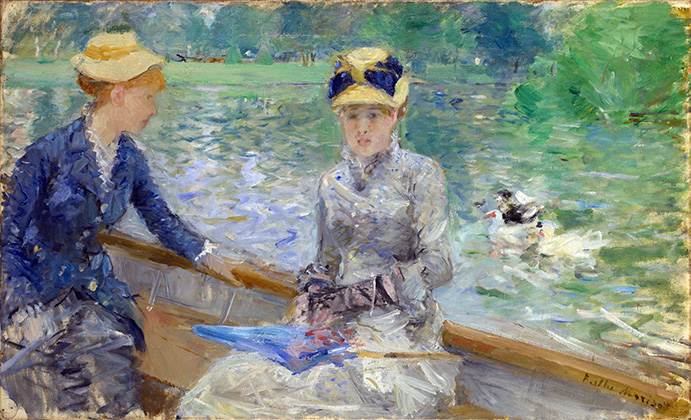
Before joining the first Impressionist exhibit with artists like Claude Monet, Paul CézannePaul Cézanne (1839–1906) is often hailed as the "father of modern art." His pioneering approach to painting laid the groundwork for the transition from 19th-century artistic traditions to the radically different styles of the 20th century. Known for his innovative use of color, brushstrokes, and composition, Cézanne's work profoundly influenced future generations of artists, including the Fauves, Cubists, and Abstract More, Edgar Degas, Camille Pissarro, and Pierre-Auguste Renoir, she successfully exhibited her work at the esteemed, government-sponsored Paris Salon, the annual exhibition of the Académie des beaux-arts in Paris. Having a close relationship with artist Éduard Manet – he painted several portraits of her – she later married his brother Eugène Manet.
Morisot focused on paintingPainting is a fundamental form of visual art that has been practiced for thousands of years. It involves applying pigment to a surface such as canvas, paper, or a wall. Painting can be explored through various styles, techniques, and mediums, each offering unique possibilities for expression and creativity. Historical Background • Ancient Beginnings: The history of painting dates back to More domestic scenes in small scale, mostly using charcoalCharcoal is a popular and expressive medium used in drawing. Known for its deep blacks and range of tones, charcoal allows artists to create dramatic and dynamic artworks with a distinct, textured look. Historical Background • Ancient Beginnings: Charcoal has been used since prehistoric times, with early humans using burnt sticks to create drawings on cave walls. These early works More, pastels, and watercolour to present women and their children in everyday life in France. Critics, however, considered her work to be too “feminine” disliking her light and feathery touch. Morisot’s journals have been handed down to today, proving her struggles as a female painter in the male dominated art world. She recorded: “I don’t think there has ever been a man who treated a woman as an equal and that’s all I would have asked for, for I know I’m worth as much as they.”
Recommended Reading:
Jean-Dominique Rey (2018): Berthe Morisot (Langue anglaise)
Sylvie Patry (2018): Berthe Morisot, Woman Impressionist
Marianne Mathieu (2012): Berthe Morisot (Editions Hazan)
Marie Bracquemond (1840–1916)
Until the 1980s, the work of Marie BracquemondMarie Bracquemond, a French painter born in 1840, played a significant role in the Impressionist movement despite facing numerous challenges. Her talent and perseverance have earned her a place among the great artists of her time. Early Life and Background • Birth: December 1, 1840, in Argenton-en-Landunvez, France. • Family: Grew up in a modest family with an interest in More was somewhat obscure, notwithstanding being referred to as one of “the three grand women artists” of Impressionism. Most of what we know about her today comes from a short biography that her only child, Pierre, wrote about his mother. It was her husband, Félix, however, who resented her career and was famously contemptuous of the Impressionist style, hindering and downplaying the artistic development of female artists.
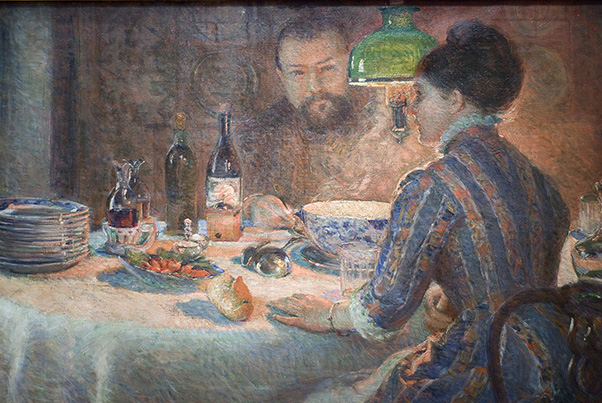
Bracquemond began her career as an academic painter. She was accepted as a pupil to the famous painter Jean-Auguste-Dominique Ingres but feared his stern nature and disliked the unequal treatment of women painters. In the 1880s, she met Claude MonetFrench painter Claude Monet (1840 – 1926) was a key figure of the impressionist movement which started in the second half of the 19th century. During his long career, Monet focused on depicting leisure activities and plein air landscape painting. Born in Paris, his family moved to Le Havre in Normandy when Claude was 5 years old. From early on, More, Edgar Degas, later Paul Gauguin, and began to incorporate the loose brushworkMasterful brushwork is often the defining feature of great artists, where the brush becomes an extension of their arm, allowing paint to flow effortlessly onto the canvas. These artists demonstrate a profound understanding of their medium, knowing precisely when to apply thick, textured strokes or smooth, delicate ones. Their skill extends beyond mere color application; it's about the artistry of More and the light-infused palette of ImpressionismImpressionism was an art movement of the 19th century developed in France, based on the practice of painting spontaneously out-doors (“en plein air”) rather than in the studio. Key impressionist subjects were everyday scenes and landscapes, in which the momentary and transient effects of sunlight should be captured. The artists worked directly in front of their subjects, using rapid brushwork More into her paintingPainting is a fundamental form of visual art that has been practiced for thousands of years. It involves applying pigment to a surface such as canvas, paper, or a wall. Painting can be explored through various styles, techniques, and mediums, each offering unique possibilities for expression and creativity. Historical Background • Ancient Beginnings: The history of painting dates back to More, often working en plein airThe French term “en plein air” means “out-doors”. Plein air painting therefore refers to the practice of painting an entire finished picture out of doors. Artists have long worked out of doors to create landscape sketches for the preparation of further studio work. The plein air approach, finishing entire pictures out-doors, however, began only in the 19th century, initiated by More. Having developed her own distinctive approach, she followed the invitation to participate in the Impressionist exhibitions in 1879, 1880, and 1886.
Throughout her career, Bracquemond produced drawings, prints, and paintings with a restricted range of subject matter, covering the standard themes for women artists of Impressionists such as domestic scenes, portraits, still-lives, and landscapes. It would have been inappropriate for a female painter in the 19th century to paint a nude or move about the modern city unaccompanied. The artist is known for having worked reclusive as she aged, mainly paintingPainting is a fundamental form of visual art that has been practiced for thousands of years. It involves applying pigment to a surface such as canvas, paper, or a wall. Painting can be explored through various styles, techniques, and mediums, each offering unique possibilities for expression and creativity. Historical Background • Ancient Beginnings: The history of painting dates back to More in the garden of her home in the southwestern Parisian suburb of Sèvres.
Recommended Reading:
Jean-Paul Bouillon (2008): Women Impressionists: Berthe Morisot, Mary Cassatt, Eva Gonzalès, Marie Bracquemond
Bridget Alsdorf et al. (2017): Women Artists in Paris, 1850-1900
Mary Cassatt (1844–1926)
Mary Cassat is famous both for her art and for being principled and socially active promoting women rights. She was the only American woman artist who was invited to exhibit with the French Impressionists. Despite her father’s opposition, she enrolled at the Pennsylvania Academy of Fine Arts, which was unusual for a young woman of high social standing at that time. However, when she found the teaching methods unsupportive of female artists, she escaped to Paris to study works of the Old Masters firsthand and where she sought training from private tutors in the Louvre. In 1868, one of her portraits was selected by the prestigious Paris Salon, which was decisive for her career.

Despite she felt indebted to the Salon regarding public recognition, Cassat increasingly felt constrained by its inflexible guidelines. After meeting Edgard Degas, she began experimenting with different mediums and materials, making great progress with oil pastels, and perfecting her Impressionist brushstroke. Like Berthe Morisot and Marie BracquemondMarie Bracquemond, a French painter born in 1840, played a significant role in the Impressionist movement despite facing numerous challenges. Her talent and perseverance have earned her a place among the great artists of her time. Early Life and Background • Birth: December 1, 1840, in Argenton-en-Landunvez, France. • Family: Grew up in a modest family with an interest in More, Cassat mainy stuck to paintingPainting is a fundamental form of visual art that has been practiced for thousands of years. It involves applying pigment to a surface such as canvas, paper, or a wall. Painting can be explored through various styles, techniques, and mediums, each offering unique possibilities for expression and creativity. Historical Background • Ancient Beginnings: The history of painting dates back to More domestic scenes, women, and their children in quiet moments. She was later influenced by the Japanese Ukiyo-eUkiyo-e, meaning "pictures of the floating world," is a genre of Japanese art that flourished from the 17th to the 19th century. These woodblock prints and paintings capture the vibrant urban culture of Edo-period Japan, depicting everything from beautiful women to dramatic landscapes. Origins and Development • Period: Emerged during the Edo period (1603-1868) • City of Origin: Edo (modern More art using flat and monochromatic colour tonesIn color theory, a tone is a version of a color created by adding gray (a mix of black and white) to the original hue. This concept is essential for artists and designers as it allows for a wide range of colors that are neither too dark nor too light, providing versatility in creating depth, mood, and harmony within a More.
Mary Cassatt never married being aware that she would have to sacrifice her artist career if she did so. She was an outspoken feminist who did not fear to confront men who dismissed her, often reflecting her attitude in her pictures. Even when she was no longer able to paint due to deteriorating eyesight in her later life, she still supported women rights and especially the movement for women’s suffrage.
Recommended Reading:
Pierre Curie et al. (2018): Mary Cassatt: An American Impressionist in Paris
Judith A. Barter et al. (2019): Cassatt: Mothers and Children (Mary Cassatt Art book, Mother and Child Gift book, Mother’s Day Gift)
Margarita Esters (2015): Mary Cassatt: 109 Paintings In Colour
Tina Blau (1845–1916)
Even if neglected many decades by art historians, today Tina Blau is considered one of the most important Austrian female painters of the 19th century. She had to face many difficulties as a female artist and was denied to study at the Academy of Fine Arts in Vienna. Her father, however, noticed and supported her talent early on in her life, providing private paintingPainting is a fundamental form of visual art that has been practiced for thousands of years. It involves applying pigment to a surface such as canvas, paper, or a wall. Painting can be explored through various styles, techniques, and mediums, each offering unique possibilities for expression and creativity. Historical Background • Ancient Beginnings: The history of painting dates back to More classes starting when she was 13 years old, and later sending her to an art school in Munich. Several study trips led her to Hungary, Transylvania, Bohemia, Italy, and the Netherlands. She found further inspiration in the landscapes around Vienna, in the schools of Barbizon and Fontainebleau, and in Jugendstil.
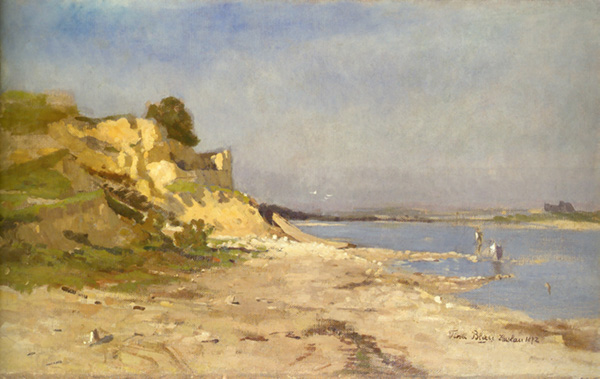
For many years, she shared a studio with Emil Jacob Schindler, who was publicly considered to be her teacher. Blau denied this relationship and protested the notion of the times that a woman could only produce meaningful art with a male teacher by her side. She was increasingly successful paintingPainting is a fundamental form of visual art that has been practiced for thousands of years. It involves applying pigment to a surface such as canvas, paper, or a wall. Painting can be explored through various styles, techniques, and mediums, each offering unique possibilities for expression and creativity. Historical Background • Ancient Beginnings: The history of painting dates back to More still lives and landscapes, having one of her pictures shown at the World Fair in 1873.
In 1883, Tina Blau, who was of Jewish descent, converted to the Protestant Church and married artist Heinrich Lang the same year. Together they moved to Munich, where Blau could teach paintingPainting is a fundamental form of visual art that has been practiced for thousands of years. It involves applying pigment to a surface such as canvas, paper, or a wall. Painting can be explored through various styles, techniques, and mediums, each offering unique possibilities for expression and creativity. Historical Background • Ancient Beginnings: The history of painting dates back to More at the Ladies Academy of the Munich Female-Artist-Society. In an exhibition, she showed 60 of her paintings, most of them in the style of the Austrian Stimmungsimpressionismus (“mood impressionists”).
After her husband’s death in 1891 she travelled through the Netherlands and Italy for ten years and finally returned to Vienna. As a founding member of the “Kunstschule für Frauen und Mädchen” (Art School for Girls and Women), the female artist taught landscape and still lifeStill Life refers to a genre of art that focuses on depicting inanimate objects. These objects are typically commonplace items, arranged in a composition to highlight their shapes, colors, textures, and forms. The genre is known for its attention to detail and the meticulous arrangement of elements, creating a sense of balance and harmony. Historical Background Still life painting has More paintingPainting is a fundamental form of visual art that has been practiced for thousands of years. It involves applying pigment to a surface such as canvas, paper, or a wall. Painting can be explored through various styles, techniques, and mediums, each offering unique possibilities for expression and creativity. Historical Background • Ancient Beginnings: The history of painting dates back to More, and in 1899 had her first group exhibition.
Hilma af Klint (1862–1944)
Swedish artist Hilma af Klint’s paintings were among the first abstract art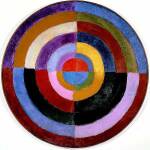 Abstract artworks diverge from depicting recognizable scenes or objects and instead use colors, forms, and lines to create compositions that exist independently of visual references from the natural world. This movement, which gained momentum in the early 20th century, was propelled by artists such as Wassily Kandinsky, Piet Mondrian, and Kazimir Malevich. These artists aimed to explore spiritual, emotional, and More, even predating the first purely abstract compositions by Wassily KandinskyWassily (Vasily) Kandinsky (1866 – 1944) is known as one of the pioneers of abstract modern art. He was born in in Moscow to upper-class parents of mixed ethnic origins. At an early age, Kandinsky showed a rare sensitivity towards music and the arts, which his father strongly supported. Kandinsky decided to study law, ethnography, and economics, and started successfully More, Kazimir Malevich, and Piet Mondrian. However, it was not until the Guggenheim Museum hosted a major survey of the female artist in 2018 that she was finally recognized as a pioneer of abstract paintingPainting is a fundamental form of visual art that has been practiced for thousands of years. It involves applying pigment to a surface such as canvas, paper, or a wall. Painting can be explored through various styles, techniques, and mediums, each offering unique possibilities for expression and creativity. Historical Background • Ancient Beginnings: The history of painting dates back to More.
Abstract artworks diverge from depicting recognizable scenes or objects and instead use colors, forms, and lines to create compositions that exist independently of visual references from the natural world. This movement, which gained momentum in the early 20th century, was propelled by artists such as Wassily Kandinsky, Piet Mondrian, and Kazimir Malevich. These artists aimed to explore spiritual, emotional, and More, even predating the first purely abstract compositions by Wassily KandinskyWassily (Vasily) Kandinsky (1866 – 1944) is known as one of the pioneers of abstract modern art. He was born in in Moscow to upper-class parents of mixed ethnic origins. At an early age, Kandinsky showed a rare sensitivity towards music and the arts, which his father strongly supported. Kandinsky decided to study law, ethnography, and economics, and started successfully More, Kazimir Malevich, and Piet Mondrian. However, it was not until the Guggenheim Museum hosted a major survey of the female artist in 2018 that she was finally recognized as a pioneer of abstract paintingPainting is a fundamental form of visual art that has been practiced for thousands of years. It involves applying pigment to a surface such as canvas, paper, or a wall. Painting can be explored through various styles, techniques, and mediums, each offering unique possibilities for expression and creativity. Historical Background • Ancient Beginnings: The history of painting dates back to More.
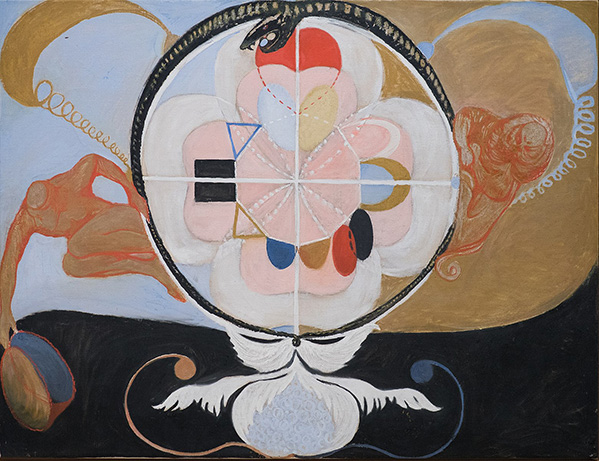
Born 1862 in Stockholm, she later studied at the Royal Academy of Fine Arts of the city and then began her career as landscape and portrait painter after graduating in 1887. She further served as secretary of the Association of Swedish Women Artists. At that time, Theosophy and spiritualism gained momentum as the public searched for a way to unite scientific advancements with religion.
Af Klint was strongly influenced by this spirituality and participated in a group called “The Five”, a circle of women with whom she shared the belief in the significance of trying to contact the so-called “High Masters” by séances. Af Klint’s first major group of nonfigurative paintings was strongly inspired by and a means to this spirituality. Called “The Paintings for the Temple”, the 193 works were part of her activities in the group, resembling diagrams and exemplifying representations of complex spiritual ideas with which she explored the dual perception of evolution, the universe, and creation. Afraid that the pictures would be misunderstood by contemporaries, she instructed that the works should not be exhibited until 20 years after her death.
After Hilma af Klint had completed the works for the Temple, she believed that the spiritual guidance had ended. Notwithstanding, she continued to pursue diverse forms of abstract paintingPainting is a fundamental form of visual art that has been practiced for thousands of years. It involves applying pigment to a surface such as canvas, paper, or a wall. Painting can be explored through various styles, techniques, and mediums, each offering unique possibilities for expression and creativity. Historical Background • Ancient Beginnings: The history of painting dates back to More independently, now mainly using watercolours instead of oil paintings and smaller formats. Throughout her life, af Klint would continuously seek to understand the mysteries which she had encountered through her artistic work and produced more than 150 notebooks with thoughts and studies.
Iris Müller-Westermann et al. (2020): Hilma af Klint: Artist, Researcher, Medium
Kurt Almqvist et al. (2020): Hilma af Klint: Visionary (STOLPE PUBLISHI)
Tracey Bashkoff (2018): Hilma af Klint: Paintings for the Future
Kurt Almqvist et al. (2020): Hilma af Klint: Seeing Is Believing (STOLPE PUBLISHI)
Margaret Macdonald Mackintosh (1864–1933)
English-born artist Margaret Macdonald Mackintosh’s design work became one of the defining features of the Glasgow Style, the British Art NouveauIn the desire to abandon the historical styles of the 19th century and overcome historicism in architecture and decoration, Art Noveau appeared in a wide variety of strands worldwide, most popular between 1890 and 1910. The movement is also known as the Glasgow Style, in the German-speaking world, as Jugendstil, or as Stile Liberty in Italian. Enthusiasts in the decorative More style, in the 1890s. Together with her sister Frances, she studied design at the Glasgow School of Art working in a variety of media including embroidery, metalwork, and textiles.
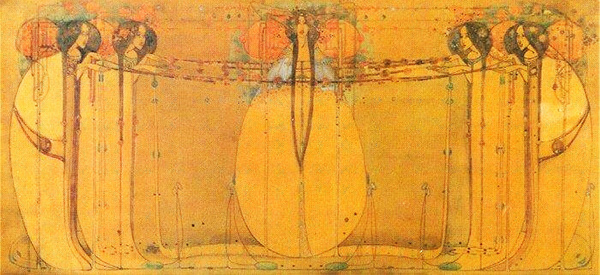
The two female artists were strongly inspired by Celtic imagery, symbolismSymbolism was a late 19th-century art movement of French, Belgian, and Russian origin. Poets and fine artists were seeking to represent absolute truths using metaphorical images in reaction against realism and naturalism. Content of both images and poetry were suggestive contents to express mystical ideas, emotions, and states of mind. Paul Gauguin, Nave Nave Mahana (1869) The term was coined More, and poems by William Morris and Dante Gabriel Rossetti. Mackintosh largely drew from her imagination and not from nature, not keeping any sketchbooks. In the beginning of her career, she widely experimented by reinterpreting traditional themes, allegories, and symbols in inventive ways, for example transforming abstract concepts like time and the four seasons into stylized human forms. Her design demonstrated a type of independence that distinguished her from other artists of her time.
At the Glasgow School the two sisters met world-renowned architect and designer Charles Rennie Mackintosh and James Herbert MacNair. The two female artists established a studio in Glasgow and soon began to collaborate with Mackintosh and MacNair, together quickly cementing their international reputations. Her most well-known works are gesso panels created for interiors such as private residences and tearooms. Mackintosh and Margaret married in 1900. Since Mackintosh was frequently claimed to be Scotland’s most celebrated architect, Margaret was often marginalized in comparison. However, she was celebrated by many of her contemporaries who highly appreciated her artistic genius. During her career between 1895 and 1924, she contributed her works to more than 40 European and American exhibitions.
Suzanne Valadon (1865 – 1938)
Suzanne Valadon is remembered both as a model for many artists in Paris such as Pierre-Auguste Renoir and Henri de Toulouse-Lautrec and as a painter in her own right. Born Marie-Clémentine, Valadon was the daughter of an unmarried laundress in Montmartre and did not know her father. She is renowned for having been quite rebellious and independent, dropping out of primary school at the age of 11 to start various jobs in the bohemian quarter of Paris, among them working at a factory making funeral wreaths, as a waitress, and as an acrobat in a circus.
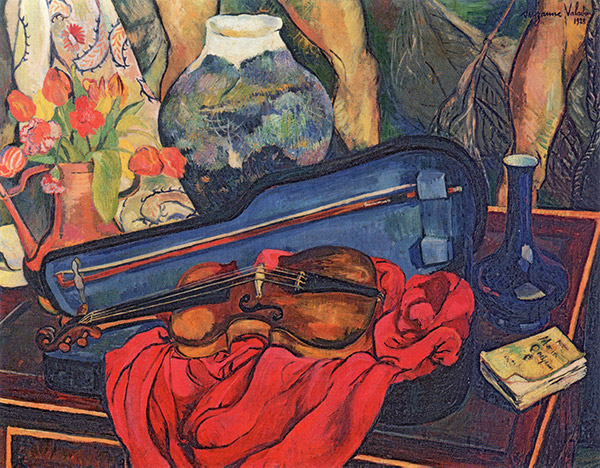
Starting 1880, Valadon modelled for several of the most prominent painters at that time. Not being able to afford formal art classes herself, she learned readily from the artists around her when modelling. Edgar Degas became her mentor, teaching her drawingDrawing is a foundational art form that involves creating images on a surface, typically paper, using tools such as pencils, pens, and charcoal. It is a versatile medium that allows artists to express ideas, emotions, and stories through lines, shapes, and shading. Historical Background • Prehistoric Beginnings: The earliest known drawings date back to prehistoric times, with cave drawings found More and etching techniques, so that she soon could move from the artist’s model to being a successful woman artist, and beginning to paint full-time in 1896. Her work centred around still lifes, landscapes, portraits, and flowers, all painted in vibrant colours. However, she became best known for her candid female nudes, depicting women from a women’s perspective in a symbolist and post-impressionist manner. By paintingPainting is a fundamental form of visual art that has been practiced for thousands of years. It involves applying pigment to a surface such as canvas, paper, or a wall. Painting can be explored through various styles, techniques, and mediums, each offering unique possibilities for expression and creativity. Historical Background • Ancient Beginnings: The history of painting dates back to More unidealized nudes, she upset social norms of the time.
Valadon had a complicated personal life. When she was 18 years old, she gave birth out of wedlock to Maurice Utrillo, who later became an artist himself. She married and divorced twice and had a short affair with the French composer Eric Satie. Her personal story and her work as a female artist have been of great interest to feminist art historians, especially her focus on the female form, and her resistance to academic and avant-garde conventions.
Recommended Reading:
Nancy Ireson (2021): Suzanne Valadon: Model, Painter, Rebel
Catherine Hewitt (2019): Renoir’s Dancer: The Secret Life of Suzanne Valadon
June Rose (1999): Suzanne Valadon: The Mistress of Montmartre
Elaine Todd Koren (2001): Suzanne: of Love and Art
Florine Stettheimer (1871–1944)
American artist Florine Stettheimer was one of the most intriguing figures in New York’s vibrant art scene during the first half of the 20th century. Her pictures and poems, designs for stages and studios, constitute a modern synthesis of the consumer culture, including skyscrapers, Wall Street, beauty contests, and revelries of celebrities. Her oeuvre was the source of inspiration for many artists, including Andy WarholAndy Warhol (1928-1987) remains one of the most influential figures in the art world and a leading force in the Pop Art movement, which emerged in the 1950s and became prominent over the following decade. Warhol's art career extended beyond painting to include film, photography, sculpture, and music, among other mediums. His work and persona reshaped perceptions of art and More and Marcel DuchampMarcel Duchamp was a French-American artist whose work profoundly influenced the development of modern art. Known for his groundbreaking and often controversial works, Duchamp challenged conventional notions of what art could be, paving the way for movements such as Dada and Conceptual Art. Marcel Duchamp Early Life and Career Marcel Duchamp was born on July 28, 1887, in Blainville-Crevon, France. More.
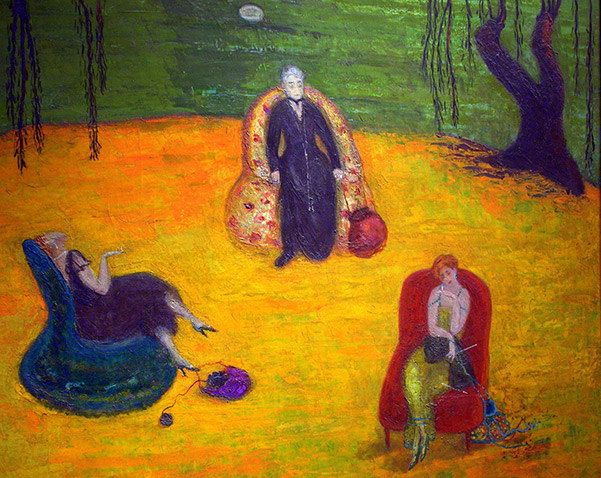
Stettheimer learned paintingPainting is a fundamental form of visual art that has been practiced for thousands of years. It involves applying pigment to a surface such as canvas, paper, or a wall. Painting can be explored through various styles, techniques, and mediums, each offering unique possibilities for expression and creativity. Historical Background • Ancient Beginnings: The history of painting dates back to More at the Art Students League in New York City, where she studied from 1892 to 1895. In 1906 she moved to Europe together with her mother and her two sisters. She continued her studies in paintingPainting is a fundamental form of visual art that has been practiced for thousands of years. It involves applying pigment to a surface such as canvas, paper, or a wall. Painting can be explored through various styles, techniques, and mediums, each offering unique possibilities for expression and creativity. Historical Background • Ancient Beginnings: The history of painting dates back to More abroad and was influenced by SymbolismSymbolism was a late 19th-century art movement of French, Belgian, and Russian origin. Poets and fine artists were seeking to represent absolute truths using metaphorical images in reaction against realism and naturalism. Content of both images and poetry were suggestive contents to express mystical ideas, emotions, and states of mind. Paul Gauguin, Nave Nave Mahana (1869) The term was coined More and Post-ImpressionismPost-Impressionism is an art movement that emerged in France in the late 19th century, following the close of the Impressionist era. While it retained the vivid color palette and real-life subject matter of Impressionism, Post-Impressionism rejected its limitations by emphasizing a more structured, formal composition and greater emotional depth. This movement was not defined by a single aesthetic but represented More.
With the outbreak the First World War, the family returned to New York City, where Stettheimer would often paint portraits of her prominent visitors. After an unsuccessful gallery exhibition in 1916, the female artist decided to pursue her art only in private, only sporadically showing her work in public. At that time, her paintings were characterized by a vivid palette of primary colours and stylized figures, critically presenting a playful view of a privileged, urban society.
Stettheimer did receive recognition during her lifetime. In 1932 her work was part of the First Biennial Exhibition of Contemporary American Painters in the Whitney Museum. Two years later she was applauded for her costume and set design for the opera “Four Saints in Three Acts” written by Getrude Stein and Virgil Thomson. The public further highly appreciated the woman artist’s final work, a series of four canvases, in which she critiqued the “cathedrals” of New York City: the financial district, department stores, the theatre and art museum.
Stephen Brown et al. (2017): Florine Stettheimer: Painting Poetry
Karin Althaus (2021): Florine Stettheimer (Great Masters in Art)
Irene Gammel et al. (2019): Florine Stettheimer: New Directions in Multimodal Modernism
Paula Modersohn-Becker (1876 – 1907)
German artist Paula Modersohn-Becker’s ground-breaking life and work expose the restrictions imposed on women artists in the early 20th century. Inspired by the style of Post-Impressionism, her starting point was to investigate and learn from everyday life with a focus on the female experience, creating un-idealized paintings of young girls, old women, and especially expectant and new mothers. She further painted landscapes, still lifes, and domestic scenes, but it was portraits of women, that occupied her artistic imagination the strongest.
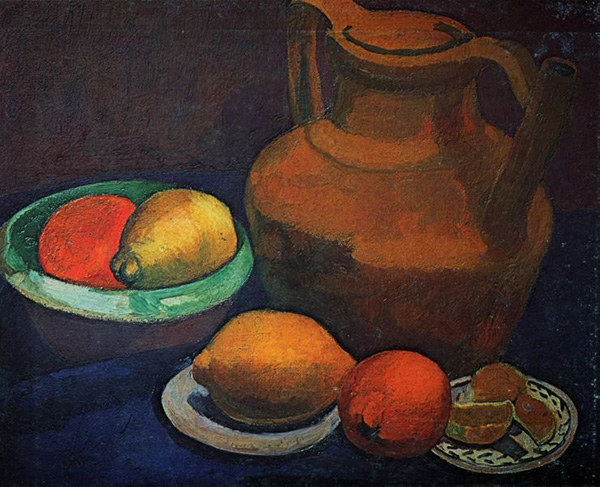
Modersohn-Becker came of age at a time when German artists moved away from academic conventions towards looser brushworkMasterful brushwork is often the defining feature of great artists, where the brush becomes an extension of their arm, allowing paint to flow effortlessly onto the canvas. These artists demonstrate a profound understanding of their medium, knowing precisely when to apply thick, textured strokes or smooth, delicate ones. Their skill extends beyond mere color application; it's about the artistry of More and a focus on shifting qualities of light which was characteristic of French ImpressionismImpressionism was an art movement of the 19th century developed in France, based on the practice of painting spontaneously out-doors (“en plein air”) rather than in the studio. Key impressionist subjects were everyday scenes and landscapes, in which the momentary and transient effects of sunlight should be captured. The artists worked directly in front of their subjects, using rapid brushwork More. With only little support of her family, she began paintingPainting is a fundamental form of visual art that has been practiced for thousands of years. It involves applying pigment to a surface such as canvas, paper, or a wall. Painting can be explored through various styles, techniques, and mediums, each offering unique possibilities for expression and creativity. Historical Background • Ancient Beginnings: The history of painting dates back to More when she was 16, studied in London and Berlin, and, against her father’s will, settled in an artist’s colony in the northern German town of Worpswede, where she sought to live closer to nature and escape industrialization. At the colony, she met her future husband, Otto Modersohn.
Using a subdued, earthy palette and applying thick surfaces of impasto, she avoided conventional beauty. But not only in her handling of paint did she subvert the norms. She worked as a professional female artist at a time when women were expected to be mothers and wives. And she portrayed women in a way that offended traditional standards of femininity, often showing sturdy bodies in awkward positions and saucer-like eyes.
Modersohn-Becker was unhappy in her marriage and avoided becoming a mother, afraid she might not be able to focus on her career as an artist. She regularly spent longer periods of time in Paris, where she would learn from the avant-garde, meeting artists like Paul CézannePaul Cézanne (1839–1906) is often hailed as the "father of modern art." His pioneering approach to painting laid the groundwork for the transition from 19th-century artistic traditions to the radically different styles of the 20th century. Known for his innovative use of color, brushstrokes, and composition, Cézanne's work profoundly influenced future generations of artists, including the Fauves, Cubists, and Abstract More, Paul Gauguin, and Vincent van Gogh. Through these influences, she developed her own style which was close to the later German Expressionism. Changing her mind about motherhood, she went back to Worpswede. She died only days after giving birth to a daughter of complications when only 31 years old. Modersohn-Becker left behind a vast correspondence with artist friends and many diaries, giving us insights into her desire to be respected as a woman artist.
Paula Modersohn-Becker (2018): Paula Modersohn-Becker – Paintings & Drawings
Marie Darrieussecq et al. (2017): Being Here Is Everything: The Life of Paula Modersohn-Becker (Semiotext(e) / Native Agents)
T. Andratschke et al. (2020): Paula Modersohn-Becker (Great Masters in Art)
Natalia Goncharova (1881-1962)
Natalia Goncharova’s oeuvre span across various avant-garde movements of the early 20th century. Today one of the most famous women artists, she combined modernismThe term Modernism refers to a global movement in society and culture which sought the departure from traditional forms of thinking in favour of the creation of new forms of art, philosophy, and social organisation. Reflecting the transformations in western society during the late 19th and early 20th centuries and the newly emerging industrial world provided the impetus to depart More with traditional Russian folk artFolk art represents the creative expressions of ordinary people, often rooted in community traditions and cultural practices. It encompasses a wide range of artistic forms and styles, reflecting the everyday life, beliefs, and values of various cultures. Unlike fine art, folk art is typically created by self-taught artists, and its beauty lies in its simplicity and directness. Characteristics of Folk More, orientalism, ornamental depicturing of figures, icon paintingPainting is a fundamental form of visual art that has been practiced for thousands of years. It involves applying pigment to a surface such as canvas, paper, or a wall. Painting can be explored through various styles, techniques, and mediums, each offering unique possibilities for expression and creativity. Historical Background • Ancient Beginnings: The history of painting dates back to More, and CubismSynthetic cubism was the later period of the Cubist art movement generally dated from 1912 – 1919. Artists of Synthetic Cubism moved away from the multi-perspective approach of Analytical Cubism in favour of flattened images that dispensed allusions of the three-dimensional space. Pablo Picasso, Clarinet, Bottle of Bass, Newspaper, Ace of Clubs (2013) The approach of the analytical phase was More. Besides paintings, she created numerous sculptures and was a stage designer for the Ballets Russes. With Mikhail Larionov she founded the art movement of Rayonism in 1910.
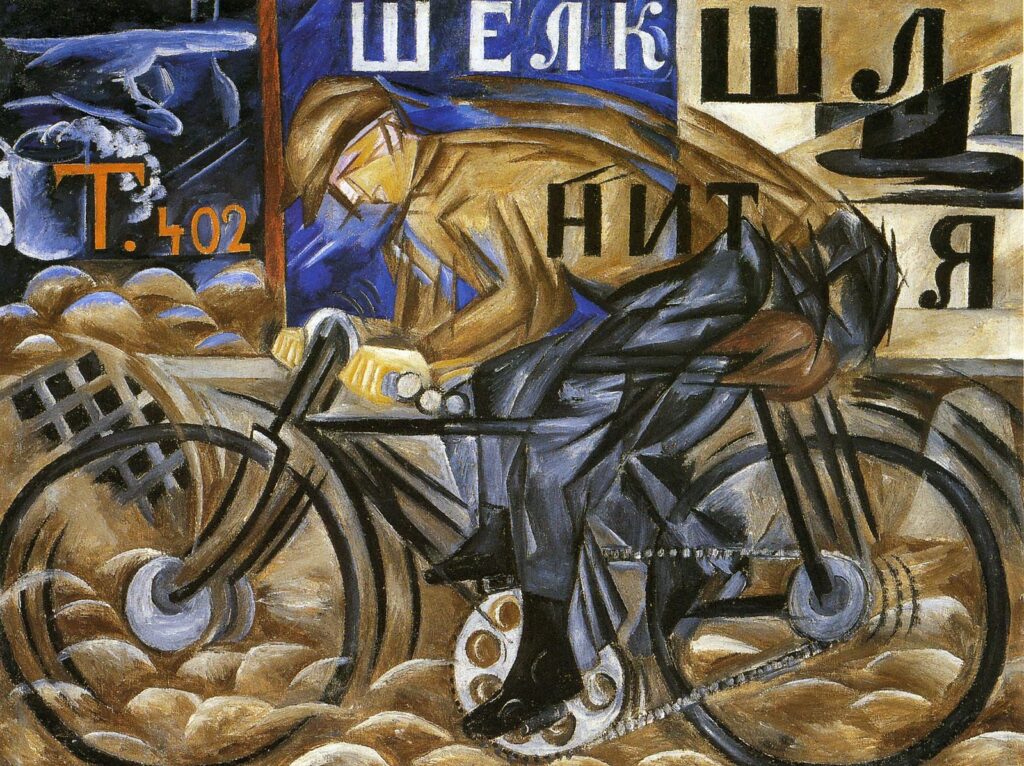
As the daughter of an aristocratic family, Goncharova was able to study paintingPainting is a fundamental form of visual art that has been practiced for thousands of years. It involves applying pigment to a surface such as canvas, paper, or a wall. Painting can be explored through various styles, techniques, and mediums, each offering unique possibilities for expression and creativity. Historical Background • Ancient Beginnings: The history of painting dates back to More and sculptureSculpture refers to a three-dimensional art form created by shaping or combining materials. Sculptors use various techniques to carve, model, cast, or construct their works, resulting in pieces that can be viewed from multiple angles. History and Origin Sculpture has a long history, dating back to prehistoric times. Early humans carved figures from stone, bone, and wood. These early sculptures More at the Moscow School of PaintingPainting is a fundamental form of visual art that has been practiced for thousands of years. It involves applying pigment to a surface such as canvas, paper, or a wall. Painting can be explored through various styles, techniques, and mediums, each offering unique possibilities for expression and creativity. Historical Background • Ancient Beginnings: The history of painting dates back to More, SculptureSculpture refers to a three-dimensional art form created by shaping or combining materials. Sculptors use various techniques to carve, model, cast, or construct their works, resulting in pieces that can be viewed from multiple angles. History and Origin Sculpture has a long history, dating back to prehistoric times. Early humans carved figures from stone, bone, and wood. These early sculptures More, and Architecture. While focusing on sculptureSculpture refers to a three-dimensional art form created by shaping or combining materials. Sculptors use various techniques to carve, model, cast, or construct their works, resulting in pieces that can be viewed from multiple angles. History and Origin Sculpture has a long history, dating back to prehistoric times. Early humans carved figures from stone, bone, and wood. These early sculptures More first, she shifted her focus to paintingPainting is a fundamental form of visual art that has been practiced for thousands of years. It involves applying pigment to a surface such as canvas, paper, or a wall. Painting can be explored through various styles, techniques, and mediums, each offering unique possibilities for expression and creativity. Historical Background • Ancient Beginnings: The history of painting dates back to More after meeting Larionov. In 1910 she was a founding member of the avant-garde artists group “Jack of Diamonds”. However, she and Larionov soon formed another short-lived group called “Donkey’s Tail” in 1911 aiming to cultivate a Russian ModernismThe term Modernism refers to a global movement in society and culture which sought the departure from traditional forms of thinking in favour of the creation of new forms of art, philosophy, and social organisation. Reflecting the transformations in western society during the late 19th and early 20th centuries and the newly emerging industrial world provided the impetus to depart More inspired by Russian artistic traditions without the influence of Western traditions and the aesthetic concepts current in Paris. With this notion as basis, Goncharova and Larionov conceived of Rayonism, an approach that meant to show in two dimensions the spatial qualities of reflected light.
Goncharova was able to successfully present her art in many different social circles. She took part in Roger Fry’s Post-Impressionist exhibition in London and in the second exhibition of the German “Der Blaue Reiter” in Munich. In 1913 an impressive retrospective in Moscow showed more than 700 of her works. She further earned high reputation for her costume design for the Kamerny Theatre and as a designer for Serge Diaghilev’s Ballets Russes in Paris.
After the First World War, Goncharova and Larionov moved to Paris permanently and became French citizens in 1939.
Recommended Reading:
Natalia Sidlina et al. (2019): Natalia Goncharova
Jane Ashton Sharp (2005): Russian Modernism between East and West: Natal’ia Goncharova and the Moscow Avant-Garde
Yevgenia Petrova (2005): Natalia Goncharova: The Russian Years
Sonia Delaunay (1885-1979)
Sonia Delaunay was a Ukrainian-born French painter and designer best known for her bold use of colourful geometric shapes. Born Sarah Élievna Stern to a poor Jewish family in Odessa, she was sent to live with her wealthy uncle Henri Terk at the age of five. The Terks changed her name to Sonia, and, discovering her talent for art, sent her to the Karlsruhe Academy of Fine Arts in Germany. She moved to Paris in 1906 to further pursue her career as a woman painter at the Académie de La Palette in Montparnasse.

During the early days in Paris, Sonia was strongly influenced by Post-ImpressionismPost-Impressionism is an art movement that emerged in France in the late 19th century, following the close of the Impressionist era. While it retained the vivid color palette and real-life subject matter of Impressionism, Post-Impressionism rejected its limitations by emphasizing a more structured, formal composition and greater emotional depth. This movement was not defined by a single aesthetic but represented More, especially by Vincent van GoghVincent van Gogh (1853 – 1890) is one of the renowned Post-Impressionist artists, best known for his striking use of colour, emphatic brushwork, and contoured forms. As a son of a pastor, the Dutch artist war brought up in a religious and cultured atmosphere. After working unsuccessfully as a clerk at a bookstore, as a salesman, and as a preacher More, Paul Gauguin, Henri Rousseau, and by FauvismThe Fauvism art movement applies to a group of modernist artists in the early 20th century including Henri Matisse and André Derain, who emphasized strong colour contrasts and painterly qualities with fierce brushwork over realistic values. Fauvism as a style started around 1904 and continued far beyond 1910. The group of Fauves however only worked together for the years between More including Henri Matisse and André Derain, shown in the shift to vivid colours and strong contour lines. She met her future husband Robert Delaunay, with whom she pioneered a fusion of Neo-Impressionism and CubismSynthetic cubism was the later period of the Cubist art movement generally dated from 1912 – 1919. Artists of Synthetic Cubism moved away from the multi-perspective approach of Analytical Cubism in favour of flattened images that dispensed allusions of the three-dimensional space. Pablo Picasso, Clarinet, Bottle of Bass, Newspaper, Ace of Clubs (2013) The approach of the analytical phase was More, later called Orphism by poet Guillaume Apollinaire. The Orphism art movement and the concepts of geometric abstraction served as Delaunay’s guiding principle in creating paintings, fabrics, furniture, clothing, and designs during her career. She was highly successful during her lifetime, becoming the first living female to have a retrospective at the Louvre Museum in 1964, and in 1975 being named an officer of the French Legion of Honour.
Delaunay died 1979 in France at the age of 95. Today her works are presented in the collections of the Carnegie Museum of Art in Pittsburgh, the Hermitage Museum in St. Petersburg, and the Museum of Modern Art in New York.
Cecile Godefroy et al. (2015): Sonia Delaunay
Marta Ruiz del Árbol et al. (2017): Sonia Delaunay: Art, Design and Fashion (FUNDACION COLEC)
Morano Elizabeth (1996): Sonia Delaunay: Art into Fashion
Georgia O’Keeffe (1887–1986)
As woman artist at the forefront of American ModernismThe term Modernism refers to a global movement in society and culture which sought the departure from traditional forms of thinking in favour of the creation of new forms of art, philosophy, and social organisation. Reflecting the transformations in western society during the late 19th and early 20th centuries and the newly emerging industrial world provided the impetus to depart More, Georgia O’Keeffe is one of the most well-known female painters in history. Her early work led to bold experiments in abstraction, contrasting the dominant movement of American realismRealism is an art movement that emerged in the mid-19th century, emphasizing the depiction of subjects as they appear in everyday life. It rejects the idealized forms and dramatic expressions of Romanticism, focusing instead on accuracy, truthfulness, and the mundane aspects of the human experience. Realism strives to capture the world in a straightforward and unembellished manner. Gustave Courbet, The More. The theories of Russian artist Wassily KandinskyWassily (Vasily) Kandinsky (1866 – 1944) is known as one of the pioneers of abstract modern art. He was born in in Moscow to upper-class parents of mixed ethnic origins. At an early age, Kandinsky showed a rare sensitivity towards music and the arts, which his father strongly supported. Kandinsky decided to study law, ethnography, and economics, and started successfully More strongly inspired O’Keeffe to explore the idea that music could be translated into something visual, to achieve pure expression free of external references. She further is known for her large and provocative flowers and skull paintings, as well as for American southwestern landscapes and New York City scrapers.
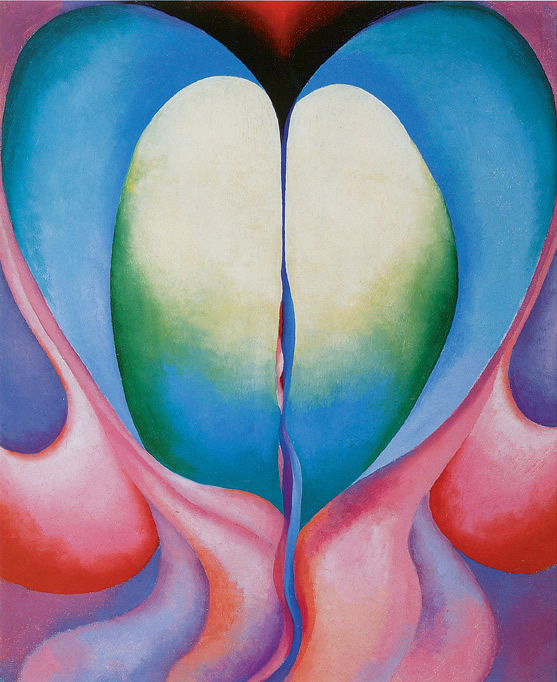
O’Keeffe grew up on a farm in Wisconsin and, after graduating from high school in 1905, was determined to make her way as an artist. She studied at the Art Institute of Chicago and the Art Students League in New York, where she acquired skills and techniques of traditional paintingPainting is a fundamental form of visual art that has been practiced for thousands of years. It involves applying pigment to a surface such as canvas, paper, or a wall. Painting can be explored through various styles, techniques, and mediums, each offering unique possibilities for expression and creativity. Historical Background • Ancient Beginnings: The history of painting dates back to More. Her artistic style changed vehemently towards abstraction when she studied the revolutionary ideas of Arthur Wesley Dow. Through a series of charcoalCharcoal is a popular and expressive medium used in drawing. Known for its deep blacks and range of tones, charcoal allows artists to create dramatic and dynamic artworks with a distinct, textured look. Historical Background • Ancient Beginnings: Charcoal has been used since prehistoric times, with early humans using burnt sticks to create drawings on cave walls. These early works More drawings, she developed a unique language to express her ideas and feelings, which attracted public attention. Art dealer and photographer Albert Stieglitz, who eventually became O’Keeffe’s husband, was the first person to display her work in 1916.
During the 1920, O’Keeffe was widely recognized as a prominent women artist, renowned for her symbolic skyscraper pictures and the radical depiction of flowers. In 1929, O’Keeffe made her first trip to New Mexico, where the stark landscape and the Hispanic culture inspired a new direction in her art. She would spend most summers living and working in New Mexico for the next two decades and made the state her permanent residence in 1949 after Stieglitz’s death. During the 1950s, she travelled internationally and painted many places she visited, including Japan’s Mount Fuji and the mountain peaks of Peru. Suffering from failing vision, O’Keeffe painted her last unassisted oil paintingPainting is a fundamental form of visual art that has been practiced for thousands of years. It involves applying pigment to a surface such as canvas, paper, or a wall. Painting can be explored through various styles, techniques, and mediums, each offering unique possibilities for expression and creativity. Historical Background • Ancient Beginnings: The history of painting dates back to More in 1972.
Recommended Reading:
Chris Dercon (2016): Georgia O’Keeffe
Barbara Buhler Lynes et al. (2004): Georgia O’Keeffe and New Mexico: A Sense of Place
Alicia Inez Guzman (2017): Georgia O’Keeffe at Home
Roxana Robinson (2020): Georgia O’Keeffe: A Life
Lyubov Popova (1889–1924)
Russian avant-garde artist, designer, and art theorist Lyubov Popova was the first female artist of Cubo-Futurism developed in Russia. The art movement combined the style of CubismSynthetic cubism was the later period of the Cubist art movement generally dated from 1912 – 1919. Artists of Synthetic Cubism moved away from the multi-perspective approach of Analytical Cubism in favour of flattened images that dispensed allusions of the three-dimensional space. Pablo Picasso, Clarinet, Bottle of Bass, Newspaper, Ace of Clubs (2013) The approach of the analytical phase was More, developed in France, with the Futurism of Italy. On this basis she explored the Suprematist movement blooming in 1913 in Russia, in which geometric forms of squares, rectangles, and circles were used as integral parts of the compositions. Besides her iconic paintings, Popova is also known for her large-scale posters, book covers, ceramicsCeramics, the art of creating objects from clay and other raw materials, is a practice that spans cultures and millennia. From ancient pottery to contemporary sculpture, ceramics have evolved in style, technique, and function, reflecting the diverse cultures and histories of civilizations worldwide. Historical Overview Ceramics have been a part of human civilization since prehistoric times, with each region developing More, photomontages, and fabric prints, later completely devoting her artistic creation to industrial design.
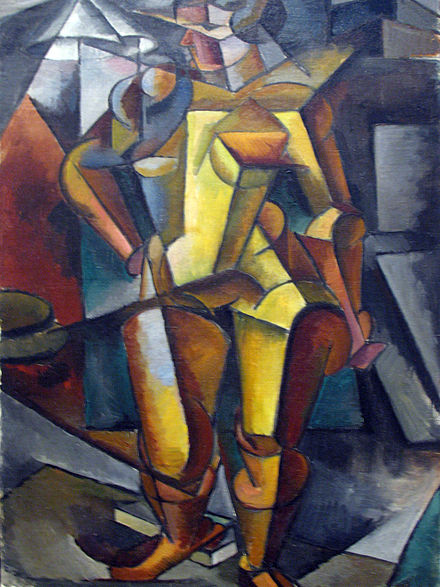
Lyubov Popova was born into a wealthy family of Moscow factory owners, which secured her a high-quality educational background. Having studied in the studios of Konstantin Yuon in Moscow, she travelled to Italy and was deeply impressed by Renaissance art. She made a crucial step in her artistic development pursuing her career further at the Parisian Académie de la Palette, where she learned about the varieties of CubismSynthetic cubism was the later period of the Cubist art movement generally dated from 1912 – 1919. Artists of Synthetic Cubism moved away from the multi-perspective approach of Analytical Cubism in favour of flattened images that dispensed allusions of the three-dimensional space. Pablo Picasso, Clarinet, Bottle of Bass, Newspaper, Ace of Clubs (2013) The approach of the analytical phase was More and later about Art NouveauIn the desire to abandon the historical styles of the 19th century and overcome historicism in architecture and decoration, Art Noveau appeared in a wide variety of strands worldwide, most popular between 1890 and 1910. The movement is also known as the Glasgow Style, in the German-speaking world, as Jugendstil, or as Stile Liberty in Italian. Enthusiasts in the decorative More. Back in Moscow, she organized weekly gatherings with fellow artists and participated in numerous exhibitions, such as the “Jack of Diamonds” show in 1914.
In 1916, the female painter joined Kazimir Malevich’s Supremus Group, and fascinated by his art style of Suprematism, developed her own variation of nonobject art in “Painterly Architectonics” in which she combined the flatness and linearity of medieval Russian art with avant-garde techniques. From 1921 on, she shifted further to ConstructivismConstructivism is a revolutionary art movement that originated in Russia in the early 20th century, right after the Russian Revolution. It's a term that captures an entirely new approach to art and architecture, distinguished by its devotion to modernity, functionality, and the embrace of technology and industrial materials. Constructivism marks a bold departure from the art for art's sake philosophy, More and towards applied arts, working with textiles and for theatre design. At the peak of her artistic success, Popova died aged just 35 in Moscow, just days after the death of her son, from whom she had contracted scarlet fever.
Recommended Reading:
Jacek Michalak (2015): 50 Color Paintings of Lyubov Popova – Russian Avant-garde Painter (April 24, 1889 – May 25, 1924)
Ingrid Schaffner et al. (2004): From Picasso To Pollock: Modern Art from the Guggenheim Museum
Hans Bellmer et al. (2004): Drawing from The Modern, Volume I: 1880-1940
Alma Thomas (1891-1978)
American painter Alma Thomas is best known for her abstract compositions and colour field paintings. She often translated natural phenomena, historical references, and personal ideas into simple compositions of circular and linear form, which recall the techniques of Pointillism and Abstract ExpressionismThe term Abstract Expressionism is applied to new forms of abstract art developed by American painters such as Mark Rothko, Jackson Pollock, and Willem de Kooning, flourishing between 1943 and the mid-1950s. Since Abstract Expressionism marked the beginning of New York City as the centre of the Western art world, the movement is also known as the New York School. More. Thomas was actively involved in the arts community of Washington D.C., where she taught art at Shaw Junior High School for 35 years and became associated with the Washington Colour School. She vehemently refused to accept discriminatory labels and restrictions on herself and her work as a female artist. At the age of 80, she became the first African American woman featured in a solo show at the Whitney Museum of American Art in 1972.
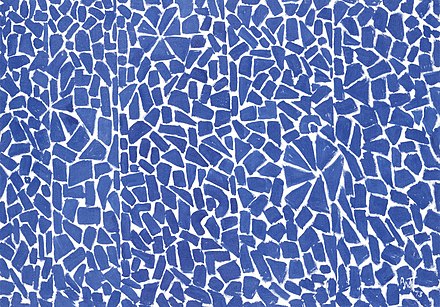
Born in Columbus, Georgia, Thomas was the eldest of four daughters born to a well-respected family. Living in a large Victorian house on a hill, she and her sisters spent her childhood observing the beauty and colour of nature. The family moved to Washington, D.C. to escape discrimination, where Thomas later enrolled in Howard University, becoming the first graduate of its newly formed art department. In the 1930s, she earned a Master of Arts degree in education from Columbia University. During her teaching career, she further studied paintingPainting is a fundamental form of visual art that has been practiced for thousands of years. It involves applying pigment to a surface such as canvas, paper, or a wall. Painting can be explored through various styles, techniques, and mediums, each offering unique possibilities for expression and creativity. Historical Background • Ancient Beginnings: The history of painting dates back to More under Joe Summerford, Jacob Kainen, and Robert Gates, and exhibited still lives and realistic paintings in group shows of African American artists.
Alma Thomas never married and lived in the same house her father had bought in Washington in 1907. Suffering from arthritis at the time of her retirement, she considered to give up paintingPainting is a fundamental form of visual art that has been practiced for thousands of years. It involves applying pigment to a surface such as canvas, paper, or a wall. Painting can be explored through various styles, techniques, and mediums, each offering unique possibilities for expression and creativity. Historical Background • Ancient Beginnings: The history of painting dates back to More. She changed her mind when Howard University offered to mount a retrospective of her work, now fully devoting herself to paintingPainting is a fundamental form of visual art that has been practiced for thousands of years. It involves applying pigment to a surface such as canvas, paper, or a wall. Painting can be explored through various styles, techniques, and mediums, each offering unique possibilities for expression and creativity. Historical Background • Ancient Beginnings: The history of painting dates back to More, undergoing an expressionist, and finally a non-objective phase. The final years of her life brought her awards and recognition, being honoured with a one-woman exhibition at the Whitney Museum of American Art in 1972 and the Corcoran Gallery of Art. The same year one of her paintings was selected for the permanent collection of the Metropolitan Museum of Art in New York City.
Recommended Reading:
Jonathan Frederick Walz et al. (2021): Alma W. Thomas: Everything Is Beautiful
Charlotte Etinde-Crompton et al. (2019): Alma Woodsey Thomas: Painter and Educator (Celebrating Black Artists)
Irving Sandler (2016): Women of Abstract Expressionism
Tamara de Lempicka (1898–1980)
Nicknamed “The Baroness with a Brush”, Tamara de Lempicka became known for her portraits of women and self-portraits rendered in the Art DecoArt deco, with its sleek geometry and vibrant colors, epitomizes elegance and sophistication. Originating in the early 20th century, it marked a significant departure from the flowing lines of Art Nouveau to embrace industrial progress and the modern age. This style isn't just about aesthetics; it's a reflection of cultural evolution, blending functionality with opulence in a way that continues More style. Her chic artwork oozes feminine sensuality, celebrating the independence and liberation of women at the time in between the two World Wars.
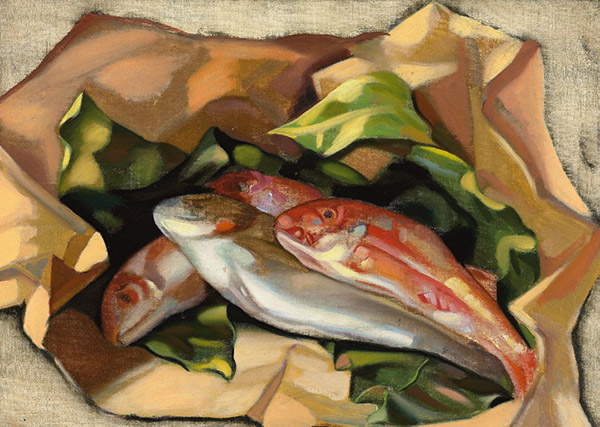
Lempicka was born in Warsaw to a Russian Jewish lawyer and a Polish socialite. Being exposed to the arts from an early age, she began paintingPainting is a fundamental form of visual art that has been practiced for thousands of years. It involves applying pigment to a surface such as canvas, paper, or a wall. Painting can be explored through various styles, techniques, and mediums, each offering unique possibilities for expression and creativity. Historical Background • Ancient Beginnings: The history of painting dates back to More when she was 10 years old. After a short stay in a boarding school in Lausanne, Switzerland, she went to live with her grandmother in Italy, where she was deeply impressed by the work of the Italian Renaissance painters. At the age of 16, she married the Polish lawyer Tadeusz de Lempicka in St. Petersburg, with whom she fled the Russian Revolution relocating in Paris. Lempicka quickly mingled with the Parisian avant-garde alongside André Gide, Jean Cocteau, and Pablo PicassoPablo Picasso (1881–1973), was a Spanish painter, sculptor, graphic artist, and resident in France from 1904. He was a dominant figure in avant-garde movements in the first half of the 20th century due to his technical versatility and prolific inventiveness. picasso-self-portrait Picasso’s progression in his early work is largely categorized by predominant colour schemes: His Blue Period (1901-1904) features motifs More, but rejected the Impressionist painters, whose style she considered “dirty”. She decided that her own style should be elegant, vivid, and clean.
In 1925, Lempicka exhibited her work for the first time in Milan and in other exclusive galleries in Europe. She achieved a breakthrough after showing her work at the International Exhibition of Modern Decorative and Industrial Arts, where fashion journalists from Harper’s Bazaar discovered her work. The woman painter further became notorious for her wild parties and the insatiable sexual appetite for both women and men. She often painted her lovers as well as the rich and famous, such as King Alfonso XIII of Spain, Italian poet Gabriele d’Annunzio, and Queen Elizabeth of Greece. Due to her scandalous lifestyle, her husband divorced her, and she could rarely see her only child Kizette.
Lempicka remarried and settled permanently in the United States with her husband before the outbreak of the Second World War, where she painted numerous portraits of Hollywood stars. However, the demand for the woman artist’s Art DecoArt deco, with its sleek geometry and vibrant colors, epitomizes elegance and sophistication. Originating in the early 20th century, it marked a significant departure from the flowing lines of Art Nouveau to embrace industrial progress and the modern age. This style isn't just about aesthetics; it's a reflection of cultural evolution, blending functionality with opulence in a way that continues More portraits declined with the rise of Abstract ExpressionismThe term Abstract Expressionism is applied to new forms of abstract art developed by American painters such as Mark Rothko, Jackson Pollock, and Willem de Kooning, flourishing between 1943 and the mid-1950s. Since Abstract Expressionism marked the beginning of New York City as the centre of the Western art world, the movement is also known as the New York School. More. Interest in her work only revived in the 1970s and has been extremely sought after her death in 1980.
Recommended Reading:
Kizette de Lempicka-Foxhall (2020): Passion by Design: The Art and Times of Tamara de Lempicka
Marisa de Lempicka (2020): Tamara De Lempicka
Laura Claridge (2010): Tamara De Lempicka (Bloomsbury Lives of Women) by Claridge, Laura (2010) Paperback
Gioia Mori (2011): Tamara De Lempicka: The Queen of the Modern
Frida Kahlo (1907–1954)
Also called “The painter of dreams”, Mexican artist Frida KahloFrida Kahlo (1907-1954) was a Mexican painter known for her deeply personal and symbolic works. Her art, characterized by vibrant colors and a unique blend of realism and surrealism, explores themes of identity, pain, and cultural heritage. Kahlo's work has gained worldwide recognition, making her one of the most celebrated artists of the 20th century. Early Life and Influences Born More created intimate self-portraits in a style located between RealismRealism is an art movement that emerged in the mid-19th century, emphasizing the depiction of subjects as they appear in everyday life. It rejects the idealized forms and dramatic expressions of Romanticism, focusing instead on accuracy, truthfulness, and the mundane aspects of the human experience. Realism strives to capture the world in a straightforward and unembellished manner. Gustave Courbet, The More, Naivety, and SurrealismSurrealism was a 20th-century philosophical, literary, and artistic movement seeking to channel the unconscious to access the imaginary. Proponents of Surrealism rejected the notion of understanding life in rational and conventional terms in favour of asserting the value of the unconscious mind, dreams, the strangely beautiful, and the uncanny. André Breton, the leader of a group of poets and artists More. Her pictures are intricately entangled with her personal biography: After a bus accident as a young woman, with her spine fractured, she had to wear a plaster corset, dealing with pain every day. In her seductive, confrontational paintings, she reflected the constant struggle between suffering, her identity, and life and death.
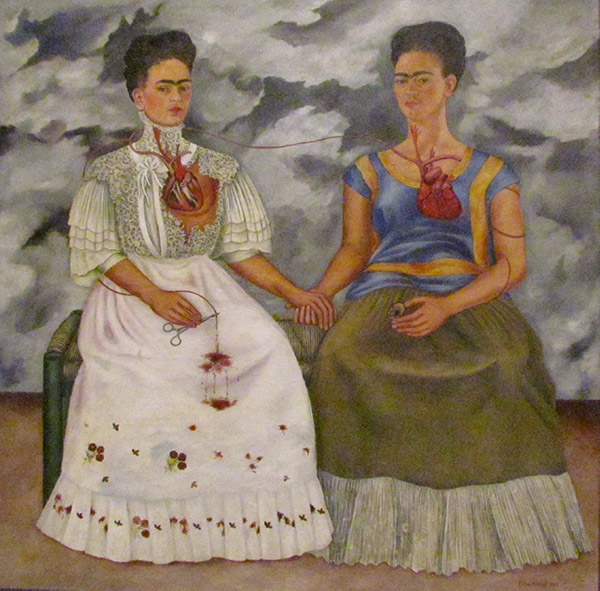
Born to a German father and a Mexican mother, Kahlo grew up in Mexico City. Around the age of six, Kahlo contracted polio which damaged her right leg. To aid in the recovery, her father encouraged her to play soccer and wrestle, which were very unusual activities for a young girl at that time. During her school years, Kahlo got politically active and joined the Young Communist League and the Mexican Communist Party. Having suffered severe injuries in a traffic accident at the age of 18, she started paintingPainting is a fundamental form of visual art that has been practiced for thousands of years. It involves applying pigment to a surface such as canvas, paper, or a wall. Painting can be explored through various styles, techniques, and mediums, each offering unique possibilities for expression and creativity. Historical Background • Ancient Beginnings: The history of painting dates back to More during her recovery.
Mexican muralist Diego Rivera in 1929, whom she married in 1929, encouraged her artwork. Following him, based on where the commissions Rivera received were, they lived in San Francisco, New York City, and Detroit. She suffered under his many infidelities, including an affair with her own sister, leading to periods of separation. Still, they joined together to support exiled Soviet communist Leon Trotsky and his wife in 1937. Kahlo divorced Rivera in 1939, only to remarry one year later.
Despite often solely referred to as “Diego Rivera’s wife”, Kahlo’s art gained momentum during the 1950s, receiving commissions from the Mexican government and a first solo exhibition in Mexico. After her death, the feminist movement of the 1970s led to renewed interest in the woman artist’s life and work, seeing her as an icon of female creativity.
Recommended Reading:
Carlos Fuentes (2005): The Diary of Frida Kahlo: An Intimate Self-Portrait
Hayden Herrera (2002): Frida: A Biography of Frida Kahlo
Gannit Ankori et al. (2021): Frida Kahlo and San Francisco
Louise Bourgeois (1911 – 2010)
As one of the greatest figures of modern and contemporary art, Louise Bourgeois commanded multiple art styles, such as Feminist art, Abstract ExpressionismThe term Abstract Expressionism is applied to new forms of abstract art developed by American painters such as Mark Rothko, Jackson Pollock, and Willem de Kooning, flourishing between 1943 and the mid-1950s. Since Abstract Expressionism marked the beginning of New York City as the centre of the Western art world, the movement is also known as the New York School. More, and SurrealismSurrealism was a 20th-century philosophical, literary, and artistic movement seeking to channel the unconscious to access the imaginary. Proponents of Surrealism rejected the notion of understanding life in rational and conventional terms in favour of asserting the value of the unconscious mind, dreams, the strangely beautiful, and the uncanny. André Breton, the leader of a group of poets and artists More. She was not formally affiliated with any art movement during her career, which span eight decades from 1930 till her death in 2010. In paintings and sculptures, the woman artist played with unconventional symbols that gave insights into her troubled memories and emotions.
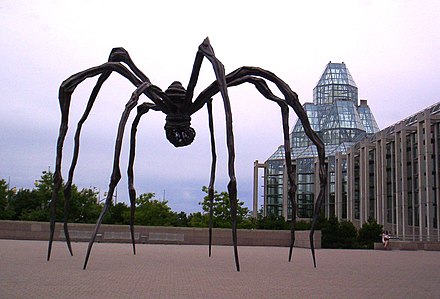
Born in Paris, Bourgeois assisted her parents in their tapestry-restoration business by making drawings for repair jobs. She entered the Sorbonne in 1932 to study mathematics but abandoned this discipline to pursue her penchant for creating art, learning at the École des Beaux-arts, at the Académie de la Grande Chaumiere, the Atelier Fernand Léger, and other Parisian schools. Having married the American art historian Robert Goldwater in 1938, she moved to New York, where she studied at the Art Students League and was able to participate in print exhibitions soon.
Focusing on large scale wood sculptures and on paintings, she had her first solo show in 1945 at the Bertha Schaefer Gallery in New York, and her work was included in the Whitney Annual. She further worked at Stanley William Hayter’s printshop, Atelier 17, where she met Joan MiróSpanish Catalan artist Joan Miró (1893 – 1983) is famous for his works in painting, sculpture, and ceramics. His work is strongly influenced by his hometown Barcelona, the scenic seaside, and the distinct style of that area. From early on, he was exposed to the arts through his parents’ professions: His mother was a goldsmith, father worked as a watchmaker. More, Le Corbusier, and other European avant-garde artists exiled by the Second World War.
Having become an American citizen, she taught art in public schools, colleges, and institutes. During the late 1960s, Bourgeois’ imagery became explicitly sexual as she explored troubled memories from her childhood: Her father had had a decade long affair with her governess. This work and some of her performance pieces found a wider audience with the rise of feminism in the 1970s. Major retrospectives were assembled all over Europe, including exhibitions at the Frankfurter Kunstverein in Frankfurt, the Venice Biennale, and the Tate Modern in London.
Recommended Reading:
Deborah Wye (2017): Louise Bourgeois: An Unfolding Portrait
Frances Morris (2019): Louise Bourgeois
Robert Storr (2016): Intimate Geometries: The Art and Life of Louise Bourgeois
Gwendolyn Knight (1913-2005)
Bajan painter and sculptor Gwendolyn Knight contributed to the Harlem Renaissance movement, lived and worked in the United States. She emerged late in her life from the shadow of her husband, the painter Jacob Lawrence. Despite not exhibiting formally until the 1970s, she began paintingPainting is a fundamental form of visual art that has been practiced for thousands of years. It involves applying pigment to a surface such as canvas, paper, or a wall. Painting can be explored through various styles, techniques, and mediums, each offering unique possibilities for expression and creativity. Historical Background • Ancient Beginnings: The history of painting dates back to More when she was young and explored new directions in old age.
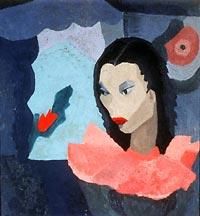
Knight was born in Bridgetown, Barbados, as only child to Malcom and Miriam Knight. Her father died when she was only two years old. At the age of seven, she travelled with a foster family to St. Louis, Missouri, and then to New York City. Being an avid reader and a dance and theatre enthusiast, Knight immersed herself in the Harlem Renaissance during her teen years. After graduating from Wadleigh High School for Girls, an integrated school in Harlem, she spent two years at the Howard University School of Fine Arts but had to drop out because of the hardships caused by Depression.
Back in Harlem, sculptor Augusta Savage became her mentor, and she met Jacob Lawrence, whom she married in 1941. In the 1960s, the couple moved to Nigeria, where Knight was strongly influenced by native arts. Like her husband, she preferred creating figural compositions rather than Abstract Expressionist paintings that other artists of her time embraced. With her vibrant imagery, primarily portraits and dancing figures, she expressed her interest in her West African heritage. She had her first one-woman exhibition in 1976.
In 2000, Lawrence and Knight established a charity foundation to support struggling women artists and a children program. Knight did not create any further art after her husband’s death the same year and fully devoted her energy towards her philanthropic efforts.
Recommended Reading:
Barbara Earl Thomas (2003): Never Late for Heaven
Glenis Redmond (2001): Gwendolyn Knight: Discovering Powerful Images: Black Mountain College Dossier n7 (Black Mountain College Dossiers)
Leonora Carrington (1917-2011)
British-born Mexican painter Leonora Carrington was one of the last surviving participants of the Surrealist movement of the 1930s and founding member of the Women’s Liberation Movement in Mexico during the 1970s.
She was born to a wealthy family of textile manufacturers in Lancashire, England. Due to her rebellious behaviour, she was expelled from two primary schools. The family then sent her to Florence, where she attended Mrs Penrose’s Academy of Art. While her father opposed her career as an artist, she was strongly encouraged by her mother. Back in London, she was able to attend the Chelsea School of Art for one year and then transferred to the Ozenfant Academy of Fine Arts.
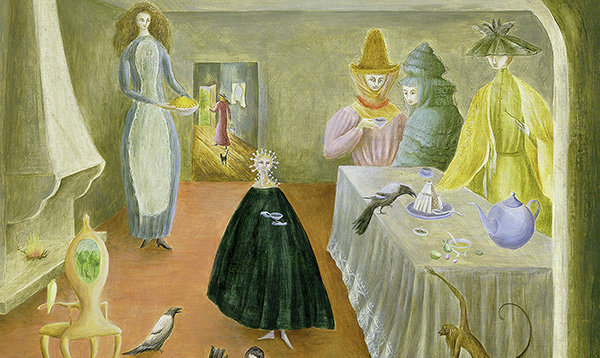
Carrington got to know the SurrealismSurrealism was a 20th-century philosophical, literary, and artistic movement seeking to channel the unconscious to access the imaginary. Proponents of Surrealism rejected the notion of understanding life in rational and conventional terms in favour of asserting the value of the unconscious mind, dreams, the strangely beautiful, and the uncanny. André Breton, the leader of a group of poets and artists More movement at the International Surrealist Exhibition in London and felt strongly attracted to Max Ernst’s pictures. The two artists met at a party in London in person, bonded, and returned together to Paris. The couple supported each other’s development in Saint Martin d’Ardèche in southern France, and Carrington began creating her own Surrealist paintings and sculptures. With the outbreak of the Second World War, Ernst was arrested by the Gestapo since the Nazis considered his work “degenerate”. He managed to flee to the United States, leaving Carrington behind, who suffered a mental breakdown and was hospitalized.
Recovering, Carrington went to South Africa, then New York, and finally Mexico, where she would stay for the rest of her life, fighting in the Women’s Liberation Movement. She primarily focused on psychic freedom, believing that such can only be achieved once political freedom is accomplished.
Recommended Reading:
Susan Aberth (2010): Leonora Carrington: Surrealism, Alchemy and ArtLeonora Carrington: Surrealism, Alchemy and Art
Leonora Carrington (2017): The Complete Stories of Leonora Carrington
Gabriel Weisz Carrington (2021): The invisible painting: My memoir of Leonora Carrington
Mira Schendel (1919-1988)
Swiss-born Brazilian artist Mira Schendel is best known for her subtle paintings, sculptures, and print. Applying delicate veils of colours, delicate lines, and symbolic elements, Schendel explored the depths of human consciousness.

Born in Zurich, Switzerland, to a Jewish family, Schendel was raised as a Roman Catholic by her mother and stepfather in Italy. Nonetheless, while studying philosophy in Milan, she was designated ethnically Jewish and persecuted by the fascist regime of Mussolini. She saw herself forced to flee to Austria and later Sarajevo, and finally emigrated to Brazil in 1949, settling in the city of São Paulo. Amidst the Brazilian cultural revolution, Schendel saw herself immersed in a vibrant scene of intellectuals and avant-garde artists.
During the 1960s she began creating her well-known series of over 2000 monotypes on Japanese rice paper and soon started experimenting with nylon thread installations and compositions using tempera and gold leaf. One primary subject of her works was to explore time and the dimensions of language, as well as the all-embracing involvement with space. Oftentimes, Schendel’s drawingDrawing is a foundational art form that involves creating images on a surface, typically paper, using tools such as pencils, pens, and charcoal. It is a versatile medium that allows artists to express ideas, emotions, and stories through lines, shapes, and shading. Historical Background • Prehistoric Beginnings: The earliest known drawings date back to prehistoric times, with cave drawings found More would be drifting towards writing, inscriptions being linked to letters and words, exploring the universality of language.
After her death in 1988, her pictures have been subject to major retrospectives, for example at the Tate Modern in London in 2013. Her works are on permanent display as part of the collections of the Museum of Modern Art in New York, the Museum of Fine Arts in Huston, and. In the Hammer Museum in Los Angeles.
Recommended Reading:
Tanya Barson (2014): Mira Schendel (Tate Modern, London: Exhibition Catalogues)
Helen Frankenthaler (1928–2011)
American artist Helen FrankenthalerHelen Frankenthaler was a trailblazing American artist known for her contributions to Abstract Expressionism and Color Field Painting. Her innovative techniques and use of color significantly influenced the development of modern art in the mid-20th century. Early Life and Career Helen Frankenthaler was born on December 12, 1928, in New York City. She studied at the Dalton School and Bennington More was a proponent of American Abstract ExpressionismThe term Abstract Expressionism is applied to new forms of abstract art developed by American painters such as Mark Rothko, Jackson Pollock, and Willem de Kooning, flourishing between 1943 and the mid-1950s. Since Abstract Expressionism marked the beginning of New York City as the centre of the Western art world, the movement is also known as the New York School. More and a major contributor to the history of post-war American paintingPainting is a fundamental form of visual art that has been practiced for thousands of years. It involves applying pigment to a surface such as canvas, paper, or a wall. Painting can be explored through various styles, techniques, and mediums, each offering unique possibilities for expression and creativity. Historical Background • Ancient Beginnings: The history of painting dates back to More. With her expansive paintings featuring forms that have been associated with natural elements and landscapes, she created a unique style that tended toward large swaths of colour. She played a pivotal role in the transition from Abstract ExpressionismThe term Abstract Expressionism is applied to new forms of abstract art developed by American painters such as Mark Rothko, Jackson Pollock, and Willem de Kooning, flourishing between 1943 and the mid-1950s. Since Abstract Expressionism marked the beginning of New York City as the centre of the Western art world, the movement is also known as the New York School. More to Colour Field paintingPainting is a fundamental form of visual art that has been practiced for thousands of years. It involves applying pigment to a surface such as canvas, paper, or a wall. Painting can be explored through various styles, techniques, and mediums, each offering unique possibilities for expression and creativity. Historical Background • Ancient Beginnings: The history of painting dates back to More, creating a body of work which would have a strong impact on contemporary art developments.
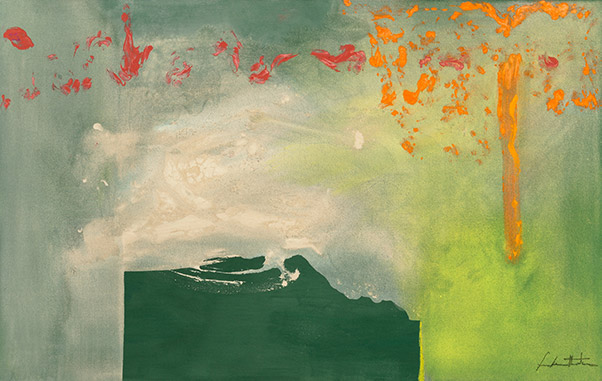
Frankenthaler was born and raised in New York. She received her first art education attending Dalton School. In 1949, she graduated from Bennington College in Vermont, where she had been a student of Paul Feeley. She was able to exhibit her work for the first time 1950 as part of a show at the Kootz Gallery, followed by her first solo exhibition in 1951 at Tibor de Nagy Gallery in New York. The woman artist’s work attracted attention from the influential art critic Clement Greenberg, which led to several exhibitions, including a solo show at the Jewish Museum in 1960. She was strongly influenced by Greenberg, furthermore by Hans Hofmann, and Jackson Pollock’s paintings. Frankenthaler became a regular presence in major international exhibition and won the first prize at the Premiere Biennale de Paris in 1959. The artist married the painter Robert Motherwell in 1960 and continued to push her experimentational paintingPainting is a fundamental form of visual art that has been practiced for thousands of years. It involves applying pigment to a surface such as canvas, paper, or a wall. Painting can be explored through various styles, techniques, and mediums, each offering unique possibilities for expression and creativity. Historical Background • Ancient Beginnings: The history of painting dates back to More style applying acrylicsAcrylics are a popular and versatile type of paint used in various art forms. Known for their vibrant colors and quick-drying properties, acrylic paints are favored by artists for their flexibility and ease of use. Historical Background • Invention and Early Use: Acrylic paint was first developed in the 1930s by chemists experimenting with synthetic resins. Initially used in industrial More on unprimed canvas.
After her death in 2011, Frankenthaler’s works have been subject of major exhibitions. Most of her works are held in collections of the National Gallery of Art in Washington, D.C., The Walker Art Center in Minneapolis, the Museum of Modern Art in New York, and the Los Angeles County Museum of Art.
Recommended Reading:
Alexander Nemerov (2021): Fierce Poise: Helen Frankenthaler and 1950s New York
Robert Slifkin et al. (2021): Imagining Landscapes: Paintings by Helen Frankenthaler, 1952–1976
Bill Berkson (2010): Helen Frankenthaler: Paintings 1961-1973
If you want to know more about the fascinating stories of female painters – of the modernist and contemporary period or earlier eras, there are many further books out there, that give them well-deserved recognition. Even if there still is a lot of research to be done, the books we recommend here all contribute to giving a good overview and building a richer picture of art history.






You might also be interested in the following posts by Pigment Pool:
ImpressionismImpressionism was an art movement of the 19th century developed in France, based on the practice of painting spontaneously out-doors (“en plein air”) rather than in the studio. Key impressionist subjects were everyday scenes and landscapes, in which the momentary and transient effects of sunlight should be captured. The artists worked directly in front of their subjects, using rapid brushwork More and JaponismeJaponisme refers to the influence of Japanese art and design on Western culture, particularly in the late 19th and early 20th centuries. This cultural phenomenon had a profound impact on various art movements, transforming Western aesthetics and creative approaches. Hokusai, Fine Wind, Clear Morning (or Red Fuji), from Thirty-six Views of Mount Fuji Origins of Japonisme • Introduction: The term More: How Japan Has Inspired Western Artists
Literature for Artists and Art Enthusiasts – 16 Essential Books on Modern Art 2021
